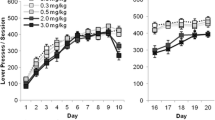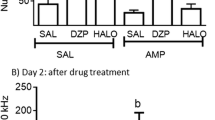Abstract
Rationale
Temporal differentiation of operant behaviour is sensitive to dopaminergic manipulations. Studies using the fixed-interval peak procedure implicated D2 dopamine receptors in these effects. Less is known about the effects of dopaminergic manipulations on temporal differentiation in other timing schedules.
Objective
To examine the effects of a D1 antagonist,8-bromo-2,3,4,5-tetrahydro-3-methyl-5-phenyl-1H-3-benzazepin-7-ol (SKF-83566), and a D2 antagonist, haloperidol, on performance on the free-operant psychophysical procedure, and the ability of these antagonists to reverse the effects of the catecholamine-releasing agent, d-amphetamine on performance. The antagonists’ ability to reverse d-amphetamine-induced hyperlocomotion was also examined.
Materials and methods
Rats responded on two levers (A and B) under a free-operant psychophysical schedule, in which reinforcement was provided intermittently for responding on A during the first half, and B during the second half, of 50-s trials. Logistic functions were fitted to the relative response rate data (percent responding on B [%B] vs time [t]) in each treatment condition, and quantitative timing indices [T 50 (value of t corresponding to %B=50) and Weber fraction] were compared among treatments. Effects of the treatments on locomotion were measured in a separate experiment.
Results
SKF-83566 (0.015, 0.03, 0.06 mg kg−1) did not affect timing performance. Haloperidol (0.025, 0.05 mg kg−1) had no effect; a higher dose (0.1 mg kg−1) reduced T 50. d-Amphetamine (0.4 mg kg−1) reduced T 50; this effect was antagonised by SKF-83566 but not by haloperidol. Both antagonists reduced d-amphetamine-induced hyperlocomotion.
Conclusions
The results suggest that d-amphetamine’s effect on performance in the free-operant psychophysical procedure is mediated by D1 rather than D2 receptors.





Similar content being viewed by others
Notes
Most drugs acting at D1 dopamine receptors do not discriminate between D1 and D5 dopamine receptors and are therefore, more precisely designated D1-like receptor agonists and antagonists. Similarly, most drugs acting at D2 receptors do not discriminate between D2, D3 and D4 receptors and are therefore, designated D2-like receptor agonists and antagonists (Seeman and van Tol 1994; Strange 2001). Throughout this paper, for the sake of simplicity, they are referred to as D1 and D2 receptor agonists and antagonists.
References
Alexander M, Rothman RB, Baumann MH, Endres CJ, Brasic JR, Wong DF (2005) Noradrenergic and dopaminergic effects of (+)-amphetamine-like stimulants in the baboon Papio anubis. Synapse 56:94–99
Al-Zahrani SS, Ho MY, Velazquez Martinez DN, Lopez Cabrera M, Bradshaw CM, Szabadi E (1996) Effect of destruction of the 5-hydroxytryptaminergic pathways on behavioural timing and “switching” in a free-operant psychophysical procedure. Psychopharmacology 127:346–352
Bayley PJ, Bentley GD, Dawson GR (1998) The effects of selected antidepressant drugs on timing behaviour in rats. Psychopharmacology 136:114–122
Bizo LA, White KG (1994a) The behavioral theory of timing: reinforcer rate determines pacemaker rate. J Exp Anal Behav 61:19–33
Bizo LA, White KG (1994b) Pacemaker rate and the behavioral theory of timing. J Exp Psychol Anim Behav Processes 20:308–321
Body S, Kheramin S, Ho M-Y, Miranda F, Bradshaw CM, Szabadi E (2003) Effects of a 5-HT2 receptor agonist DOI (2,5-dimethoxy-4-iodoamphetamine), and antagonist, ketanserin, on the performance of rats on a free-operant timing schedule. Behav Pharmacol 14:599–607
Body S, Kheramin S, Ho M-Y, Miranda Herrera F, Bradshaw CM, Szabadi E (2004) Effects of fenfluramine on free-operant timing behaviour: evidence for involvement of 5-HT2A receptors. Psychopharmacology 176:154–156
Buhusi CV (2003) Dopaminergic mechanisms of interval timing and attention. In: Meck WH (ed) Functional and neural mechanisms of interval timing. CRC, Boca Raton
Buhusi CV, Meck WH (2002) Differential effects of methamphetamine and haloperidol on the control of an internal clock. Behav Neurosci 116:291–297
Catania AC (1970) Reinforcement schedules and psychophysical judgements: a study of some temporal properties of behavior. In: Schoenfeld WN (ed) The theory of reinforcement schedules. Appleton-Century-Crofts, New York
Catania AC, Reynolds GS (1968) A quantitative analysis of the responding maintained by interval schedules of reinforcement. J Exp Anal Behav 11(Suppl):327–383
Chiang TJ, AlRuwaitea ASA, Ho MY, Bradshaw CM, Szabadi E (1998) The influence of ‘switching’ on the psychometric function in the free-operant psychophysical procedure. Behav Process 44:197–209
Chiang TJ, Al-Ruwaitea AS, Ho MY, Bradshaw CM, Szabadi E (1999) Effect of central 5-hydroxytryptamine depletion on performance in the free-operant psychophysical procedure: facilitation of switching, but no effect on temporal differentiation of responding. Psychopharmacology 143:166–173
Chiang TJ, Al-Ruwaitea AS, Mobini S, Ho MY, Bradshaw CM, Szabadi E (2000a) The effect of d-amphetamine on performance on two operant timing schedules. Psychopharmacology 150:170–184
Chiang TJ, Al-Ruwaitea AS, Mobini S, Ho MY, Bradshaw CM, Szabadi E (2000b) Effects of 8-hydroxy-2-(di-n-propylamino)tetralin (8-OH-DPAT) on performance on two operant timing schedules. Psychopharmacology 151:379–391
Drew MR, Fairhurst S, Malapani C, Horvitz JC, Balsam PD (2003) Effects of dopamine antagonists on the timing of two intervals. Pharmacol Biochem Behav 75:9–15
Eckerman DA, Segbefia D, Manning S, Breese GS (1987) Effects of methylphenidate and d-amphetamine on timing in the rat. Pharmacol Biochem Behav 27:513–515
Frederick DL, Allen JD (1996) Effects of selective dopamine D1- and D2-agonists and antagonists on timing performance in rats. Pharmacol Biochem Behav 53:759–764
Garris PA, Budygin EA, Phillips PE, Venton BJ, Robinson DL, Bergstrom BP, Rebec GV, Wightman RM (2003) A role for presynaptic mechanisms in the actions of nomifensine and haloperidol. Neuroscience 118:819–829
Gerfen CR (2004) Basal ganglia. In: Paxinos G (ed) The rat nervous system, 3rd edn. Elsevier, San Diego
Gibbon J, Malapani C, Dale CL, Gallistel C (1997) Toward a neurobiology of temporal cognition: advances and challenges. Curr Opin Neurobiol 7:170–184
Herrera FM, Velazquez Martinez DN (1997) Discriminative stimulus properties of amphetamine in a conditioned taste aversion paradigm. Behav Pharmacol 8:458–464
Hinton SC, Meck WH (1997) How time flies: functional and neural mechanisms of interval timing. In: Bradshaw CM, Szabadi E (eds) Time and behaviour: psychological and neurobehavioural analyses. Elsevier, Amsterdam
Ho MY, Velazquez-Martinez DN, Bradshaw CM, Szabadi E (2002) 5-Hydroxytryptamine and interval timing behaviour. Pharmacol Biochem Behav 71:773–785
Killeen PR, Fetterman JG (1988) A behavioral theory of timing. Psychol Rev 95:274–295
Killeen PR, Fetterman JG, Bizo LA (1997) Time’s causes. In: Bradshaw CM, Szabadi E (eds) Time and behaviour: psychological and neurobehavioural analyses. Elsevier, Amsterdam
Kraemer PJ, Randall CK, Dose JM, Brown RW (1997) Impact of d-amphetamine on temporal estimation in pigeons tested with a production procedure. Pharmacol Biochem Behav 58:323–327
Levesque M, Parent A (2005) The striatofugal fiber system in primates: a reevaluation of its organization based on single-axon tracing studies. Proc Natl Acad Sci USA 102:11888–11893
Lidsky TI, Banerjee SP (1993) Acute administration of haloperidol enhances dopaminergic transmission. J Pharmacol Exp Ther 265:1193–1198
MacDonald CJ, Meck WH (2004) Systems-level integration of interval timing and reaction time. Neurosci Biobehav Rev 28:747–769
Machado A, Guilhardi P (2000) Shifts in the psychometric function and their implications for models of timing. J Exp Anal Behav 74:25–54
Maricq AV, Roberts S, Church RM (1981) Methamphetamine and time estimation. J Exp Psychol Anim Behav Processes 7:18–30
Matell MS, Meck WH (2004) Cortico-striatal circuits and interval timing: coincidence detection of oscillatory processes. Cogn Brain Res 21:139–170
Matell MS, King GR, Meck WH (2004) Differential modulation of clock speed by the administration of intermittent versus continuous cocaine. Behav Neurosci 118:150–156
McElvain JS, Schenk JO (1992) Blockade of dopamine autoreceptors by haloperidol and the apparent dynamics of potassium-stimulated endogenous release of dopamine from and reuptake into striatal suspensions in the rat. Neuropharmacology 31:649–659
Meck WH (1986) Affinity for the dopamine D2 receptor predicts neuroleptic potency in decreasing the speed of an internal clock. Pharmacol Biochem Behav 25:1185–1189
Meck WH (1996) Neuropharmacology of timing and time perception. Cogn Brain Res 3:227–242
Meck WH, Benson AM (2002) Dissecting the brain’s internal clock: how frontal-striatal circuitry keeps time and shifts attention. Brain Cogn 48:195–211
Molloy AG, O’Boyle KM, Pugh MT, Waddington JL (1986) Locomotor behaviors in response to new selective D-1 and D-2 dopamine receptor agonists, and the influence of selective antagonists. Pharmacol Biochem Behav 25:249–253
Munoz A, Lopez-Real A, Labandeira-Garcia JL, Guerra MJ (2003) Interaction between the noradrenergic and serotonergic systems in locomotor hyperactivity and striatal expression of Fos induced by amphetamine in rats. Exp Brain Res 153:92–99
O’Boyle KM, Gaitanopoulos DE, Brenner M, Waddington JL (1989) Agonist and antagonist properties of benzazepine and thienopyridine derivatives at the D1 dopamine receptor. Neuropharmacology 28:401–405
Odum AL, Lieving LM, Schaal DW (2002) Effects of d-amphetamine in a temporal discrimination procedure: selective changes in timing or rate dependency? J Exp Anal Behav 78:195–214
Raiteri M, Bertollini A, Angelini F, Levi G (1975) d-Amphetamine as a releaser or reuptake inhibitor of biogenic amines in synaptosomes. Eur J Pharmacol 34:189–195
Roberts S (1981) Isolation of an internal clock. J Exp Psychol Anim Behav Processes 7:242–268
Rothman RB, Baumann MH, Dersch CM, Romero DV, Rice KC, Carroll FI, Partilla JS (2001) Amphetamine-type central nervous system stimulants release norepinephrine more potently than they release dopamine and serotonin. Synapse 39:32–41
Salamone JD, Cousins MS, Maio C, Champion M, Turski T, Kovach J (1996) Different behavioral effects of haloperidol, clozapine and thioridazine in a concurrent lever pressing and feeding procedure. Psychopharmacology 125:105–112
Salamone JD, Arizzi MN, Sandoval MD, Cervone KM, Aberman JE (2002) Dopamine antagonists alter response allocation but do not suppress appetite for food in rats: contrast between the effects of SKF 83566, raclopride, and fenfluramine on a concurrent choice task. Psychopharmacology 160:371–380
Seeman P, van Tol HHM (1994) Dopamine receptor pharmacology. Trends Pharmacol Sci 15:264–270
Spyraki C, Fibiger HC, Phillips AG (1982) Dopaminergic substrates of amphetamine-induced place preference conditioning. Brain Res 253:185–193
Strange PG (2001) Antipsychotic drugs: importance of dopamine receptors for mechanisms of therapeutic actions and side effects. Pharmacol Rev 153:119–133
Stubbs DA (1976) Scaling of stimulus duration by pigeons. J Exp Anal Behav 26:15–25
Stubbs DA (1980) Temporal discrimination and a free-operant psychophysical procedure. J Exp Anal Behav 33:167–185
Velazquez Martinez DN, Valencia FM, Lopez CM, Villarreal JE (1995) Effects of indorenate on food intake: a comparison with fenfluramine and amphetamine. Psychopharmacology 117:91–101
Vieira-Coelho MA, Soares-da-Silva P (2000) Ontogenic aspects of D1 receptor coupling to G proteins and regulation of rat jejunal Na+, K+ ATPase activity and electrolyte transport. Br J Pharmacol 129:573–581
Waddington JL (1986) Behavioural correlates of the action of selective D-1 dopamine receptor antagonists. Impact of SCH 23390 and SKF 83566, and functionally interactive D-1:D-2 receptor systems. Biochem Pharmacol 35:3661–3667
Ziance RJ (1977) Specificity of amphetamine induced release of norepinephrine and serotonin from rat brain in vitro. Res Commun Chem Pathol Pharmacol 18:627–644
Acknowledgements
This work was supported by the BBSRC. We are grateful to Ms. V. K. Bak and Mr. R. W. Langley for skilled technical help.
Author information
Authors and Affiliations
Corresponding author
Rights and permissions
About this article
Cite this article
Cheung, T.H.C., Bezzina, G., Asgari, K. et al. Evidence for a role of D1 dopamine receptors in d-amphetamine’s effect on timing behaviour in the free-operant psychophysical procedure. Psychopharmacology 185, 378–388 (2006). https://doi.org/10.1007/s00213-006-0339-x
Received:
Accepted:
Published:
Issue Date:
DOI: https://doi.org/10.1007/s00213-006-0339-x




